Spark Plug Info for M37 and Other Vehicles
This information was sent to me by Pete from the BigElectric M37 forum.
I downloaded the photos from the server that they were linked to and put them on
mine just to make sure that they didn't disappear on me. Otherwise, the page is
unedited from the form that I received it. For those of you who might like to print
the information out for reference, I have a PDF version.
Pete also sent me a PDF file that consists of a chart showing a variety of
spark plug tip conditions that is useful in determining and diagnosing engine conditions
and problems. The spark plug tip chart may
be found here in PDF Form.

| M37
Spark Plugs - 14mm Thread, 3/8" Reach, 13/16" Hex |
|
|
|
|
Autolite # |
Old Autolite # |
Heat Range |
Mil Spec No. |
New Champion # |
Old Champion # |
AC # |
Motorcraft # |
NGK No. |
2243 |
AR5S |
Cold |
MS35909-1 |
588 |
XMJ14 |
WR44
or WR43 |
AR5S |
|
2244 |
AR6S |
|
|
514 |
XEJ8 |
SR46E |
AR6S |
A6
OR A7 |
2245 |
AR7S |
Medium |
MS35909-2 |
517 |
XMJ17 |
WR46 |
AR7S |
BPR6HS |
2246 |
AR8S |
Hotter |
MS35908-1 |
567 |
XEJ12 |
SR47E |
AR8S |
XR45 |
2247 |
AR9S |
Hot |
MS35909-3 |
573 |
XMJ20 |
WR47 |
AR9S |
|
Firing tip configuration
As a rule of thumb, the more the spark gap is exposed
to the air/fuel mixture, the easier to initiate combustion. Better combustion equates to
more horsepower, improved throttle response and higher fuel economy. Unfortunately there
is no one "best" tip configuration for all engines. Each plug manufacturer
offers a variety of designs each with its own advantages and disadvantages. The only thing
we found the plug techs agreed on was that for performance issues, a fine wire center electrode will provide a stronger
spark from the existing voltage. However, fine wire
electrodes will not survive in many modified motors. Fortunately, there are a variety of
firing tips for you to choose from. After you have narrowed your plug choices according to
your shell construction features
and heat range, you will see each of the
remaining choices have their firing tip described and pictured.
Heat range
The term spark plug heat range refers to the speed with which the plug can transfer heat
from the combustion chamber to the engine head. Whether the plug is to be installed in a
boat, lawnmower or racecar, it has been found the optimum combustion chamber temperature
for gasoline engines is between 500░C–850░C. When it is within that range it is
cool enough to avoid pre-ignition and plug
tip overheating (which can cause engine damage), while still hot enough to burn off
combustion deposits which cause fouling.
The spark plug can help maintain the optimum combustion chamber temperature. The primary
method used to do this is by altering the internal length of the core nose, in addition,
the alloy compositions in the electrodes can be changed. This means you may not be able to
visually tell a difference between heat ranges. When a spark plug is referred to as a
"cold plug", it is one that transfers heat rapidly from the firing tip into the
engine head, which keeps the firing tip cooler. A "hot plug" has a much slower
rate of heat transfer, which keeps the firing tip hotter.
An unaltered engine will run within the optimum operating range straight from the
manufacturer, but if you make modifications such as a turbo, supercharger, increase
compression, timing changes, use of alternate
racing fuels, or sustained use of nitrous
oxide, these can alter the plug tip temperature and may necessitate a colder plug. A rule
of thumb is, one heat range colder per modification or one heat range colder for
every 75–100hp you increase. In identical spark plug types, the difference from one
full heat range to the next is the ability to remove 70░C to 100░C from the combustion
chamber.
The heat range numbers used by the various manufacturers are not universal, by that we
mean, a 10 heat range in Champion is not the same as a 10 heat range in NGK. Some
manufacturers numbering systems are opposite the other, for domestic manufacturers
(Champion, Autolite, Splitfire), the higher the number, the hotter the plug.
For Japanese manufacturers (NGK, Denso), the higher the number, the colder the plug.
Do not make spark plug changes at the same time as another engine modification such as
injection, carburetion or timing changes as in
the event of poor results, it can lead to misleading and inaccurate conclusions (an
exception would be when the alternate plugs came as part of a single precalibrated upgrade
kit). When making spark plug heat range changes, it is better to err on the side of
too cold a plug. The worst thing that can happen from too cold a plug is a fouled
spark plug, too hot a spark plug can cause severe engine damage.


Air fuel mixture
Theoretically the ideal air fuel ratio for gasoline motors is 14.7:1(14.7 lbs of air to 1
lbs. Fuel), however due to cylinder wall wetting, the fuel ratio is increased to 12.2 to
1. Ratios higher than this may be too lean and can contribute to pre-ignition or detonation. Ratios lower may
be too rich and cause fouling although some favor
a richer mixture due to a slightly slower burn and increased charge cooling (cooling from
the air/fuel mixture on intake).
Pre-ignition
Ignition of the air/fuel mixture prior to its timed ignition by a spark from the spark
plug is referred to as "pre-ignition". This can be caused by a hot spot in the
combustion chamber, improper timing, too hot a spark plug, low octane fuel, too lean an
air/fuel mixture, or engine overeating.

plug damaged due to sustained pre-ignition
Fouling
Fouling is when the spark plugs firing tip becomes coated with excessive fuel, oil, or
combustion deposits so that it is unable to produce a spark. A plug can become fouled from
continues low speed driving, improper spark plug heat range (too cold), improper timing
(over-retarded), too rich an air/fuel ratio or an oil leak into combustion chamber. A
variety of self-cleaning features are designed into most plugs to reduce fouling.

Wet fouled plug

Dry fouled plug
Timing
Advancing the ignition timing will raise the firing end temperature and becomes even more
critical when compression ratios are also increased. Adjustment in spark plug heat range is likely necessary.
Compression ratio
An increase in the compression ratio raises both the pressure and the temperature within
the combustion chamber. This will raise the spark plug tip temperature increasing the
chances of pre-ignition. Adjustment in
spark plug heat range is likely necessary,
in addition, whenever compression ratios are altered, it may be necessary to modify the
spark advance curve and recalibrate fuel system.
Fuel types
Alternate fuels can affect both heat range
and the voltage required to fire the spark plug. Different types of fuel affect the
required voltage as the bonding of the gas particles differs from one fuel to the next.
Different fuels can also affect heat range.
For example, when using LPG a colder spark plug is necessary, as LPG will raise the
combustion chamber temperature. This is because LPG is already in a gaseous form on
intake, therefore it does not use any heat to evaporate, this means there is less of a
cooling effect available from the incoming air/fuel mixture. On the other hand, methanol,
because of its heat vaporization properties, will aid in cooling, therefore a hotter plug
is required.
Nitrous
Nitrous Oxide is an efficient means of getting more oxygen into the combustion chamber.
Initially the
N2O injection will cool the incoming charge due to the energy expended on vaporization
into the air fuel mixture. However,
do to the dramatic increase in power output, the sustained use of N2O increases cylinder
temperatures to the point you may require a spark plug one or two heat ranges colder.
If the nitrous is used only for very short bursts, (less than 10 seconds), then the
standard plug can likely be used with no spark plug heat change necessary.
Turbos and Blowers
Whether using a supercharger or a turbocharger, both have the effect of increasing the
mass airflow into the engine which increases engine displacement. With the additional
displacement comes not only an increase in horsepower, but also an increase in firing tip
temperature, thus requiring a colder heat
range spark plug. If however, you have added extreme boost or a combination of boost
and other modifications, changing heat ranges may not be enough. Tip configuration may
also need to be altered, as there are a variety of firing tip choices, it would be wise to
consult your engine builder or performance tuner specialist for input.
Elevation
As the elevation increases, the atmosphere thins; this reduces the oxygen available and
alters the air fuel ratio. At 1000ft, this can decrease horsepower nearly 3%, and almost
9.5% at 3,000ft. If a race is held at elevations considerably above sea level, the air fuel mixture should be leaned. The
spark plug heat range should remain the
same unless also at high elevations, (above 3000ft), in which changing to a hotter plug
may be necessary. A small part of the lost horsepower may be regained by increasing the
spark advance a few degrees.
Ambient Temperature
As the outside temperature falls, the air density rises which increases the air mass. This
increase in mass raises the combustion pressure and temperatures, thus raising the spark
plug firing tip temperature, possibly requiring a colder plug. Conversely with a higher
outside temperature, you get the net effect of lowering internal plug firing temperatures,
possibly requiring a hotter plug. However, it is only under racing conditions and extreme
outside temperatures that a plug heat change would be warranted.
Humidity
As humidity increases, the air mass decreases. This lowers the combustion pressure and
temperatures resulting in a decrease in the temperature of the spark plug firing tip. As
humidity is only a very minor consideration in engine tuning, any performance alterations
including changing spark plug heat ranges due to humidity should be considered only by an
experienced performance tuner under serious racing conditions.
Indexing
Used by racing tuners only, indexing refers to a process whereby auxiliary washers of
varying thickness are placed under the spark plug's shoulder so that when the spark plug
is tightened, the gap will point in the desired
direction. However, without running an engine on a dyno, it is impossible to gauge which
type of indexing works best in your engine. While most engines like the spark plug's gap open to the intake valve, there are still other
combinations that make more power with the gap
pointed toward the exhaust valve.
In any case, engines with indexed spark plugs will typically make only a few more
horsepower, typically less than 1% of total engine output. For a 500hp engine, you'd be
lucky to get 5hp. While there are exceptions, the bottom line is that without a dyno,
gauging success will be difficult.
Gap Settings
A spark plugs’ tip temperature and the voltage necessary to fire the plug are
directly affected by the gap setting. Most
manufacturers set the gap from the factory for that
plugs most popular application. Unfortunately, that plug may have hundreds of applications
from automobiles to golf carts. Setting the gap for
your particular engine is important as insufficient spark plug gap can cause pre-ignition, detonation and even engine
damage. Whereas too much gap can result in a higher
rate of misfires, loss of power, plug fouling and
poor fuel economy. Even if the preset gap is supposed
to match your motor, it is always best to physically check that the gap is adjusted properly for your motor prior to
installation.
For modified motors, proper gapping is essential; gap
settings are affected by increased compression, fuel type, turbos, nitrous and high output ignition system. Most
experienced tuners know that opening the gap up to
present a larger spark to the air/fuel mixture maximizes burn efficiency, however, after
they have raised compression and installed a turbo, they have to lower the gap (to ensure ignitability in the denser air/fuel
mixtures). It is for this reason that most racers add high power ignition systems.
The added power allows them to reopen the gap without
misfire.
Increasing ignition output allows you to open the spark plug gap without increasing misfires. Opening the gap up to present a larger spark to the air/fuel mixture
maximizes burn efficiency and available horsepower. Many of the more popular aftermarket
ignition systems are of the capacitive discharge type (CDI).
They store voltage, or accumulate it, until a point at which a trigger signal allows
release of this more powerful spark. Companies like Mallory, MSD, Crane and Accel, to name
a few, offer such systems. Older non-computer controlled vehicles or engines that have
been modified with higher compression or boost can certainly take advantage of a more
powerful ignition system. When switching ignition systems, it is important to consult that
manufacturer as to the use of resistor or non-resistor plugs.
The use of high power ignition systems should be restricted to modified motors or older
motors with non-computer controlled ignition. Modern vehicles already have
computer-controlled ignition, which do such a good job of igniting the air/fuel mixture
that added ignition capacity would do little to improve fuel ignition.
Plug torque settings
It is essential to tighten a spark plug to the specified turning angle or torque setting.
This is for a number of reasons, over tightening can cause;
1) Damage to the threads in the cylinder head (especially aluminum heads).
2) Damage the threads of the spark plug.
3) Damage the internal seal of a spark plug allowing combustion chamber blow-by.
Under tightening of the spark plug can cause plug overheating and possibly pre-ignition. This is because one of the
primary purposes of the spark plug is to remove heat from the combustion chamber, it does
so by transferring that heat to the engine head. If the plug is not properly tighten it
will not have sufficient contact with the head to transfer that heat. Proper tightening
procedure is described below.
Screw in the spark plug finger tight until the gasket meets the cylinder head. Then seat the plug/gasket with a torque or turning angle
wrench as specified in the chart below
Resistor plugs for race engines
It is strongly recommended resistor spark plugs
be used in any motor that has on-board computer systems to monitor or control engine
performance. Use of a non-resistor plug in
certain applications can actually cause the engine to suffer undesirable side effects such
as an erratic idle, high-rpm misfire, engine run-on, power drop off at certain rpm levels
and abnormal combustion. Resistor plugs are also
recommended on any vehicle that has other on-board electronic systems such as, two-way
radios, GPS systems, depth finders or whenever recommended by the manufacturer.
If you have an outboard marine CDI (capacitive
discharge ignition), (such as Johnson and Evinrude), make sure to use a plug with an
inductive type resistor (such as a Champion
Q-type or NGK Z-type). Use of non-inductive resistor
type plugs on these motors can create an open circuit within the spark plug (it will
become a dead plug).
Mallory, MSD, Crane and Accel also produce a high output ignition CDI system, however, these should not be confused with a
marine style CDI as mentioned above. For an
automotive high output CDI system it is imperative
you consult that manufacturer for plug specifications for their system. Some high out put
systems specify the use of resistor plugs, while
others will fry the internal plug resistor
turning its 5k ohms into 60k ohms.
As a rule, performance is in no way impaired by resistor
spark plugs. The only exception to this may be some models of high output CDI specify non-resistor
plugs.
What is a racing plug?
Most "racing" spark plugs are just colder heat ranges of the same street
versions spark plug. Their internal construction is no different than their standard heat range equivalents. Racing spark plugs do
not make more power in an engine, rather, they allow the engine to make more power.
Meaning, after all the engine modifications are done that add power, a racing plug is
better designed to operate in the torturous conditions created by those modifications. If
you used a regular plug in a modified race engine, it would quickly be destroyed, while a
properly selected racing plug would endure the extreme limits of that motor. Take that
same racing plug, however, put it in an unmodified motor, and it would foul out within
minutes.
The differences between a racing plug and traditional plug are not solely heat range. There are firing tip
configurations necessary for survival in alternate fuel racing and situations of extreme
boost/compression (such as retracted-nose insulators or surface gap firing tips), which would run very poorly in an
unmodified motor. However, there are some very effective race plug design features
including ultra-fine wire electrodes, gold palladium, platinum, iridium
electrodes and cut back ground electrodes
that are now available in standard non-racing heat ranges, these can maximize fuel
combustion and improve performance in unmodified motors as well.
Fine wire
Fine wire center electrode come under a
variety of names depending on manufacturer, IE:(Tapered
point, Ultra-Fine electrode, Taper cut electrode, Necked down electrode). Originally designed to
improve starting and reduce fouling in two-stroke
engines, this design was found to improve performance in four-stroke engines as well. All
operate on primarily the same principle, a spark plug with fine wire electrodes will
perform better than a traditional plug. There are two reasons for this, first is because a
smaller center electrode requires less
voltage to jump the gap. This means fewer misfires,
which should be seen in higher mileage and more horsepower. The second reason is smaller
center electrodes reduce quenching. The smaller
center electrodes have required exotic metals such as platinum or iridium
so that they can still maintain (and sometimes surpass) the longevity of a traditional
spark plug. Currently the finest wire performance plugs available are made by Denso at
0.4mm diameter and by NGK at 0.7mm diameter, a traditional center electrode is typically 2.0 to 2.5mm.

Ultra fine wire center electrode, 0.4mm

Ultra-fine wire NGK iridium, 0.7mm

Fine wire Champion, 1.1mm
Gold Palladium
Gold is an excellent conductor of electricity which
makes it well suited for a performance plug. However gold is also a very soft metal,
therefore the gold alloy is mixed with palladium, (a much harder metal), to form a premium
fine wire performance plug with increased
ignitability and durability.
Platinum
Platinum is a precious metal used by nearly all spark plug manufacturers on there long
life and/or performance spark plugs. This is because of platinums high melting point which
makes it useful in two ways. On a long life spark plugs a thin wafer of platinum is bonded
at the firing point to the center electrode
(and possibly ground electrode) solely
so they dont wear as fast as a traditional plug. On a fine wire performance plug, the very tip of the center electrode is made of platinum so
that the fine wire tip will last longer. Do not
be fooled, all platinum plugs are not created equal, Platinum is a very expensive precious
metal, a $2 platinum spark plug will not have much platinum in it, and therefore will not
last as long as a $12 platinum spark plug. Some platinum plugs have only the center electrode tipped with platinum,
while others have both the center and ground electrodes platinum tipped. (By the way, it
is still not suggested that platinum plugs be used on vehicles with nitrous injection.
Thus far, there has been no problems reported regarding using iridium plugs with nitrous.)

Platinum tipped ground with fine wire platinum center electrode

Platinum tipped center and ground electrode
Iridium
Iridium is a precious metal that is 6 times harder and 8 times stronger than platinum, it has a 1,200=F higher melting point
than platinum and conducts electricity better.
This makes it possible to create the finest wire center electrode ever. Prior till now,
spark plug manufacturers have favored platinum
for their long life or performance spark plugs due to its high melting point, also the
technology did not exist to machine and bond iridium on a spark plug electrode(at least in
a cost effective manner). Champion spark plugs had already made an iridium industrial
application spark plug, but it still sells for over a hundred dollars per plug. Just now
is the technology available to effectively use iridium in a spark plug for automotive
applications. The strength, hardness and high melting point of iridium make it very well
suited for a fine wire plug. The primary
iridium plug manufacturers at this time are Denso with a 0.4mm center electrode and NGK with a 0.7mm center electrode. Both are the best
performance plugs on the market for traditional automotive use and many racing
applications.
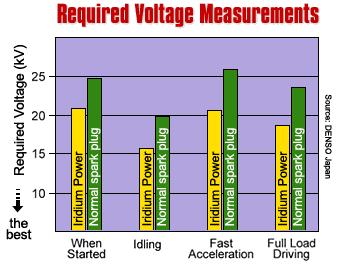
Graph applies to Denso Ultra-fine wire Iridium spark plugs
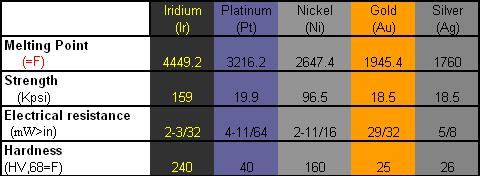
Comparison of metal properties
Cut back ground
Ground electrodes come in a variety of shapes and sizes. They are also called by a variety
of names depending on manufacturer, IE: trapezoid
cut ground, tapered cut ground,
fine wire
ground, angled ground, trimmed side
electrode, wedge shaped ground, inverted V-tip ground, cut back ground,
etc. All have the same purpose, to reduce quenching
and shadowing.

Traditional ground

Cut back Ground

Trapezoid cut

Inverted V-tip ground

Trimmed side electrode

Tapered cut ground

Wedge shaped ground
Quenching
To understand quenching and how it is reduced it is first necessary to review the basic
purpose of the spark plug is to ignite the air fuel mixture in the combustion chamber. To
do this your vehicle ignition system generates tens of thousands of volts to jump the gap between the center and ground electrodes. However it
is good to know that it is not the actual electricity that ignites the air fuel mixture,
it is the heat energy generated by that electricity or spark. Therefore when you are
creating the spark you want as much of the heat from that spark to be used to ignite the
air fuel mixture and not have the heat from that spark be re-absorbed by the center and
ground electrodes. Thus each manufacturer uses a variety of designs(cut back ground electrodes, U grooves in the
ground electrode, V-grooves in the center electrode, fine wire center and ground electrodes, tapered or
beveled cut ground electrodes, etc.) all to try to reduce quenching by reducing the
contact(surface) area between the electrodes and the flame nucleus.

Cut back ground

Quenching of standard spark plug

V-power reduces quenching

U-groove reduces quenching
Shadowing
To understand shadowing, it is good to understand first that all vehicle manufacturers try
to place the tip of the spark plug within the center of the combustion chamber (that is
the center of the combustion chamber with the piston at top dead center). This is to
expose as much of the air fuel mixture as possible to the ignition spark, the more
air/fuel exposed, the likelier chance of complete ignition (less misfires). But just as
putting a board in front of a flashlight will block the light from everything behind that
board, so the ground electrode can block
a portion of the air fuel mixture from exposure to the spark. Thus a variety of ground electrode designs are available(
fine wire
ground, cut back ground, angled ground,
etc) all help to reduce shadowing.
When are racing plugs necessary?
Not all modifications would require the use of racing plugs. Modifications that do not
alter the overall compression ratio
will not usually necessitate changing plug types or heat ranges. These would include
free-flowing air filter, headers, mufflers and rear-end gears. Such minor modifications
will not significantly increase the amount of heat in the combustion chamber, hence, a
plug change is not warranted. However, modifications that introduce new fuel types or alter compression ratios such
as turbo charging, supercharging, nitrous
oxide injection, modified cylinder heads or piston configurations, to name a few,
generally require a change from stock spark plugs. This is because, with compression
increase comes additional heat which requires a colder plug, with fuel and altered
piston/plug clearances can come firing
tip configuration changes. Typically, for every 75-100 hp you add, you should go one
full step colder on the spark plug's heat
range. If you have gone too cold you may see severe oil or fuel fouling.
Champion Part Numbering Scheme
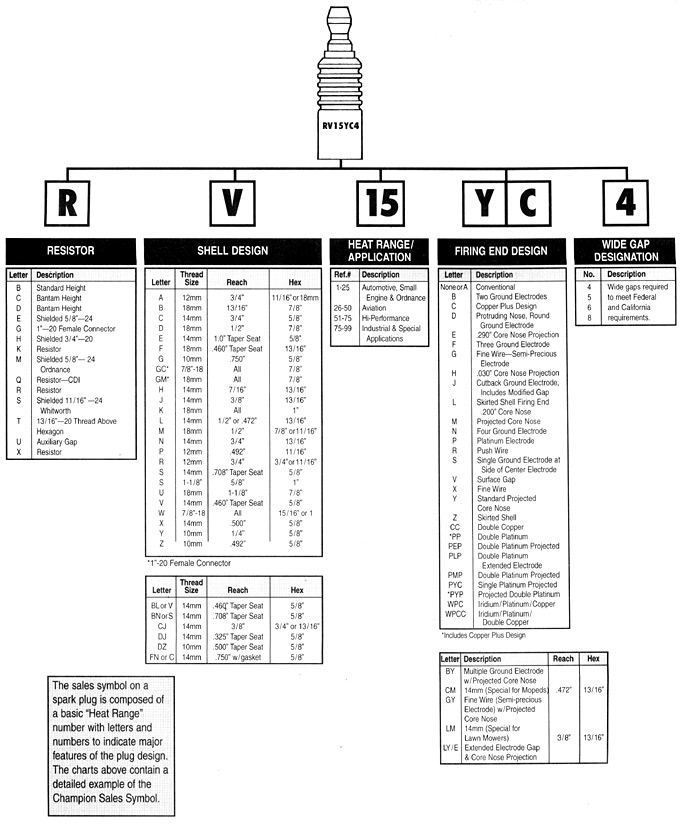
NGK Part Numbering Scheme
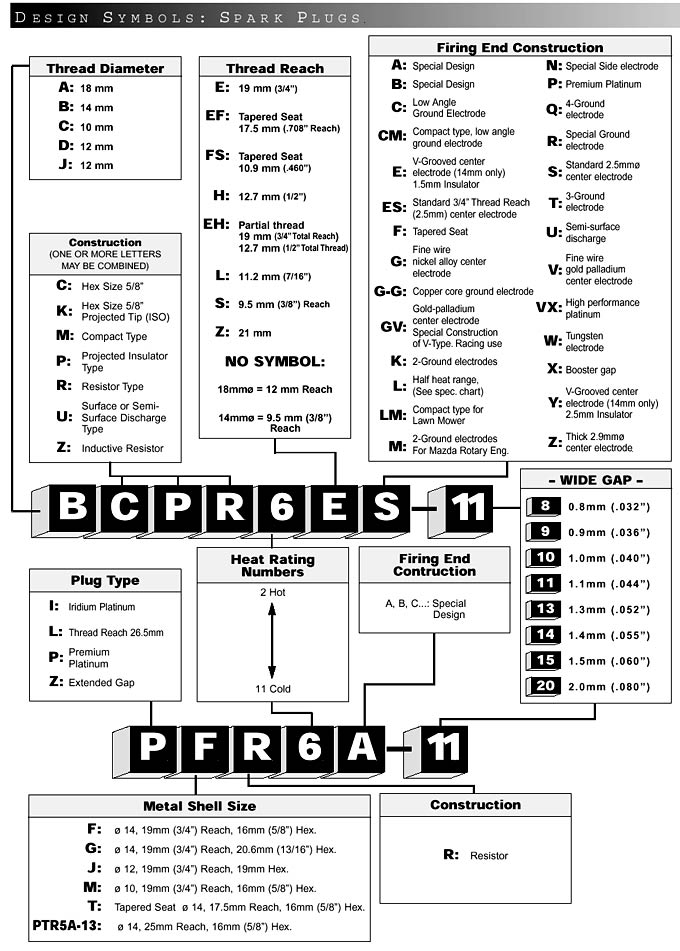
Denso Part Numbering Scheme
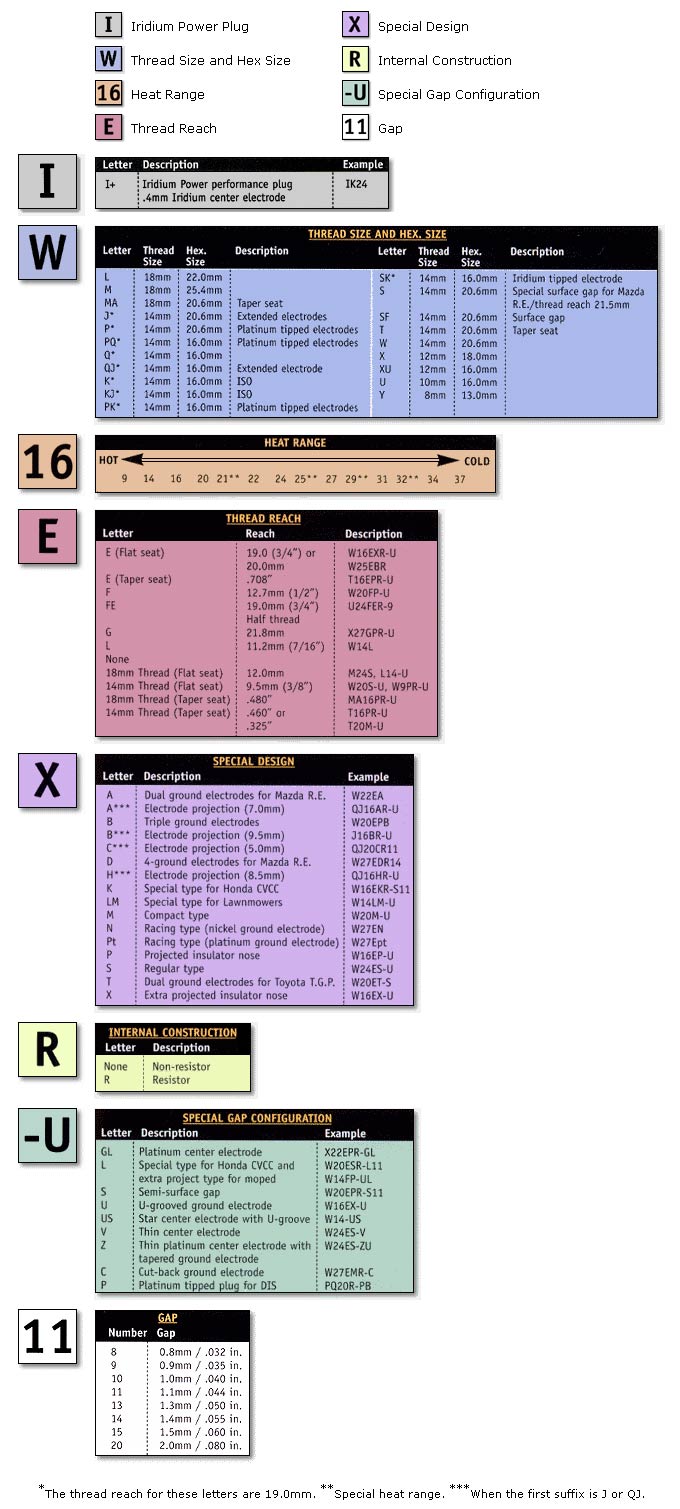
Autolite Part Numbering Scheme
Every spark plug company has a unique numbering system that may or may not have some
built in meaning. Autolite« spark plug numbers indicate the heat range with the last
number of the part number. Everything previous to that, regardless of the number of
digits, can only be used to indicate a similar design (spark plug family). For example, a
23 is one heat range colder than a 24. 3924 is one heat range hotter than the 3923. The 23
and 24 will look exactly alike, but they will not look like the 3923 or 3924.
Some part numbers also use prefixes to indicate special features. AP as in AP24 indicates
a platinum center wire on a 24. APP indicates a platinum center wire and a platinum ground
(or side) wire. MP is for motorcycle platinum and WC is especially for personal
watercraft.
Home



























